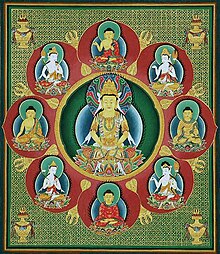Samantabhadra
Samantabhadra ( Sanskrit समन्तभद्र ; Chinese 普賢 , Pinyin Pǔxián ; Korean Pohyŏn or Bohyeon ; Japanese 普賢 fugues ; Tibetan kun tu bzang po , Mongolian Qamugha Sain , Vietnamese Phổ Hiền ) is one of the eight great Bodhisattvas of Mahayana Buddhism.
meaning
Samantabhadra is considered to be the “all-encompassing good” and “all around blessing” who protects those who explain and pass on the Dharma (Buddhist teaching). He embodies the "wisdom of equality" and goodness. He is particularly honored in the Japanese schools of Tendai-shū and Shingon, and among the followers of Nichiren Buddhism he is considered the guardian of the Lotus Sutra . In Japan, Samantabhadra as Fugen Enmei Bosatsu is also often regarded as the " extender of life".
In the tantric traditions of Buddhism , such as the Nyingma and Kagyu schools, Samantabhadra is not only considered a Bodhisattva, but also an Adibuddha . In the Tibetan Book of the Dead he is described as the Buddha who appears to the deceased during their wandering through the intermediate realm in order to free them from their still existing karmic bonds and to remind them of their original origin and destination.
According to tradition, he was known for being able to multiply offerings to Buddha through his special miraculous powers. Making offerings to Buddha "like Samantabhadra" describes a special Buddhist practice in which real offerings, in the mind of the practitioner, are made infinitely multiplied. This practice is said to be particularly suitable for accumulating merit, i.e. good karma.
iconography
Samantabhadra is seldom presented alone. He forms the so-called Shakyamuni trinity , especially in depictions from China , together with Manjushri on the sides of Buddha Shakyamuni . In Garbhadhatu - Mandala he is southeast (upper right) and represents the "basic asceticism". In the Vajradhatu mandala he is armed with a sword, the handle of which forms a three-pronged vajra . Japanese depictions show Samantabhadra ( Fugen Bosatsu ), often as a young man ( Chigo Fugen Bosatsu ).
There are different representations of Samantabhadra that show him performing different mudras and with different attributes. Its main attributes are the wish jewel ( cintamani ), the lotus and its sutra in the form of a scroll. Mostly he sits on a lotus, which is carried by a white elephant with six tusks. Other portraits show him with twenty arms, either sitting on a cubic base or four white elephants.
- Underlining his meaning as the “spirit of enlightenment ”, he is often shown performing the Anjali mudra with his hands or holding a scroll.
- Other depictions show him with a raised right hand, in which he is holding a lotus, a sutra or a vajra and performing the abhayamudra while he is holding the desired jewel in his left hand.
- In the Vajradhatu mandala, his right hand rests on his chest, palm up, with three outstretched fingers, and in his left he holds a flaming lotus.
- A shape resembling the Vajrasattva shows him holding a three-pronged vajra in front of his chest with his right hand and a bell at waist height with his left.
- In rarer portraits he can also be seen standing with a lotus under each foot, performing the abhayamudra with his right hand and slightly bent the fingers of the left, palm down.
- Also standing, he is sometimes part of a group of eight bodhisattvas. In this case he is depicted with yellow skin, a lotus in his right hand and a vajra in his left.
In Tantric Buddhism, Samantabhadra is as Adibuddha ( Ur-Buddha ), in yab-yum representations, i.e. in sexual union ( Tib . : yab-yum means "father-mother") with his radiant white wisdom companion Samantabhadri (Tib .: Kunto Zangmo ), deep blue in color. Here it symbolizes the "emptiness" ( Shunyata ), and the connection of Samantabhadra and Samantabhadri, which is also regarded as the "mother who creates all Buddhas of the three times", only emerges from the appearances of the world. His hands rest on his lap in a meditation position.
literature
- Margareta von Borsig (ex.): Lotos Sutra - The great book of enlightenment in Buddhism. Herder Verlag, new edition 2009. ISBN 978-3-451-30156-8
- Kubo Tsugunari, Yuyama Akira (tr.) The Lotus Sutra . Revised 2nd ed. Berkeley, Calif. : Numata Center for Buddhist Translation and Research, 2007. ISBN 978-1-886439-39-9 PDF (1.6 MB)


